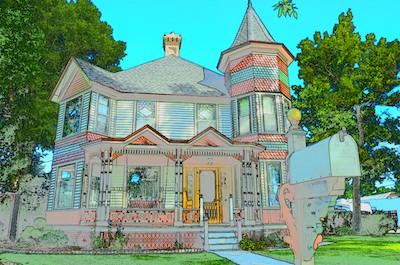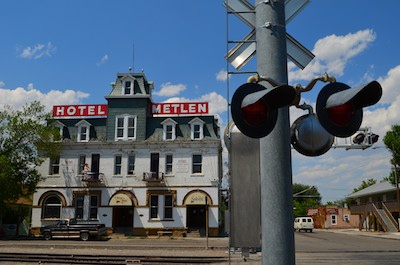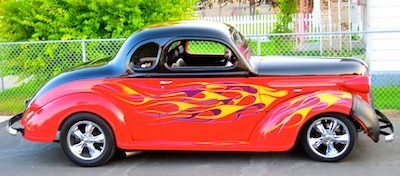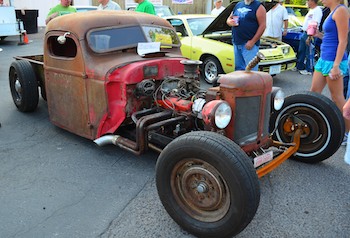
Cowboy sculpture at Dillon’s Visitor’s Center
Early August, 2012 – After a week of nature, mountains and streams in Big Hole, Montana, we were ready for a bit of town life for a while, and Dillon, Montana, fit the bill perfectly.

Sculpture outside Murdochs Ranch & Home Supply
The first thing that struck us as we walked around the quiet streets were the large bronze sculptures that graced the fronts of many businesses and the Visitors Center.
Most were made by sculptor Bradford J. Williams, a self-taught artist who grew up in eastern Colorado and specializes in western themes. Each one had a fun, fanciful sense of whimsy. Quite a few were tied to water spigots that ran continuously.

Moose sculpture in Dillon, MT

Twilight Ponderings
There was a also a big moose statue that was not one of his works but it sure caught our attention as we walked down the street.
Poking around, we learned a little of how this small railroad town came to be. Back in the 1870’s, gold mining in Montana was quite prosperous, but the camps were also very remote. After the transcontinental railroad was completed, connecting Omaha and San Francisco, smaller spurs were built to reach the hinterlands. A small gauge rail line, Utah & Northern, went from Corinne, Utah out towards Montana to bring supplies to the gold mining camps.

Grain storage near the train tracks
Building these rail lines often required the cooperation of ranch owners, and not all the ranchers were thrilled about having a railroad cut through their land. As the railroad approached the Dillon area, one rancher refused to allow the railroad through at all. However, an enterprising group of businessmen bought a different ranch and gave the railroad the right-of-way via a different route. Then these same guys established the townsite of Dillon around the train depot.

Dazzling sunflowers
The mega-entrepreneurs of our time like Steve Jobs, Bill Gates and Sam Walton all had the foresight, determination and wherewithal to change the world with their vision. But the businessmen in Montana 140 years ago — operating without any modern conveniences — had to have been made of the same stuff. Each man put up $875 for a total of $10,500, enough to buy 480 acres to build Dillon. Then they began selling lots. In no time they pocketed $14,000 and had 300 folks to populate their town.

There’s lots of history in Dillon
These founding fathers quickly built a bank, a store and a hotel, followed by a newspaper. The construction of wooden sidewalks on the main street was heralded as a true sign of civilized living, as you no longer had to pick your way through mud and sage brush to go to the store.
 That first hotel, Hotel Corinne, was not far from the old Hotel Metlen that still stands near the train tracks today. A mannequin in a long dress and bright red hat waves to visitors from one of the upstairs balconies, and next to her a sign advertises the rates from a bygone era: $10 for a room, $12 for one with a sink, and $16 for one with a bath.
That first hotel, Hotel Corinne, was not far from the old Hotel Metlen that still stands near the train tracks today. A mannequin in a long dress and bright red hat waves to visitors from one of the upstairs balconies, and next to her a sign advertises the rates from a bygone era: $10 for a room, $12 for one with a sink, and $16 for one with a bath.

Hotel Metlen stands near the site of Dillon’s first hotel
Downstairs a neon sign lights up at dusk advertising a casino with live poker. I’m not sure how busy those poker tables are now, but the hotels must have been busy in the past. Dillon grew to become an important shipping depot, not only delivering supplies to the gold mining camps, but shuttling cattle and sheep to market as well. At one time Dillon shipped more wool than any other city in Montana.

Hotel Metlen lights up at dusk

Annual Cruise Night Hot Rod!!

The Dairy Queens
This is a quiet town of less than 4,000 people, but everyone came out on the afternoon of the car show. It was the 9th Annual Cruise Night, and hot rods of all kinds were on display.
Mark was in seventh heaven roaming between them, reminiscing about the muscle cars his high school buddies had owned back in the Motor City when the auto industry was flying high.

Rusted
Our favorite was an old International that had been lowered and had a license plate that said “Rusted.” The car show was sponsored by Dairy Queen, and there were four dairy queens selling refreshments in the midst of all the action.
On the weekend everyone came out again, this time for the farmer’s market. Yummy things of all kinds were laid out on tables, and I was immediately drawn to the table from GO’s Jerky Barn where a bunch of homemade cheeses and sausages were offered for tasting. Can’t pass that up!

The Prairie Psaltry
As I was munching, I noticed a really intriguing instrument on display at the next table. It was a finely crafted wooden instrument, triangular in shape, with strings. Next to it was a bow. “It kinda looks like a cross between a violin and a zither.” I commented. “It’s a Prairie Psaltry,” the vendor, Richard, told me. “They were popular in biblical times.” He picked it up and played a few bars. It had a light, airy, sound. We chatted a little and discovered we had both lived aboard boats in Boston. Massachusetts ages ago. He lived aboard a big beautiful power yacht while I was on a sailboat. What a crazy connection!
However, sailing and boats were far from our minds as we roamed the west amid cowboys and railroads and gold mining history. Leaving Dillon, we continued our historical theme and stopped to see the antique buildings of Virginia City, Montana.
